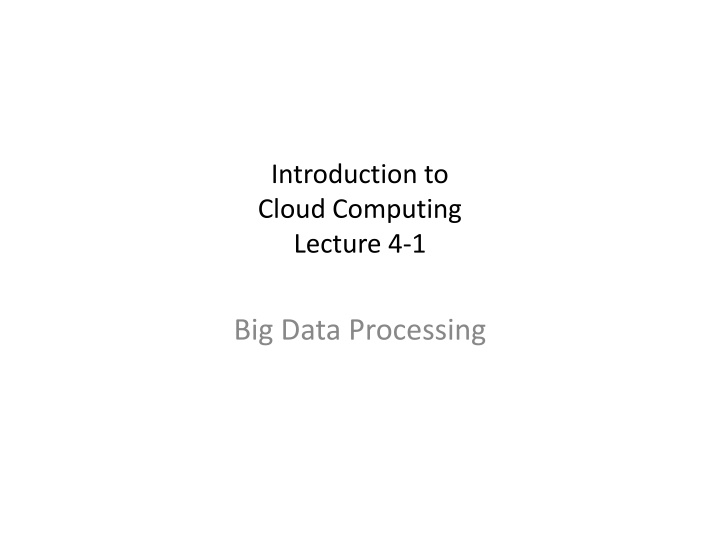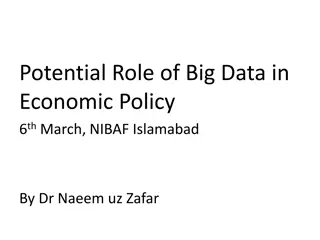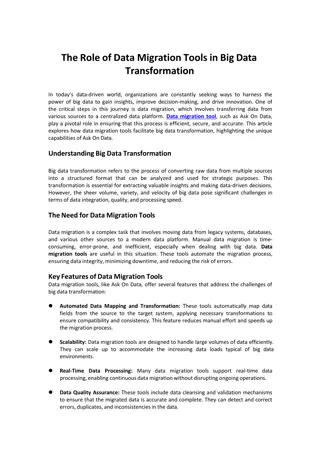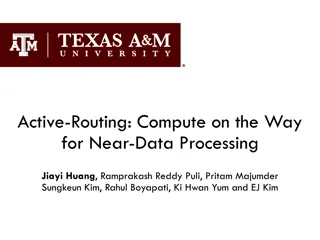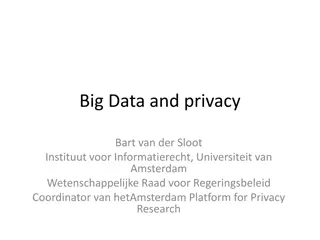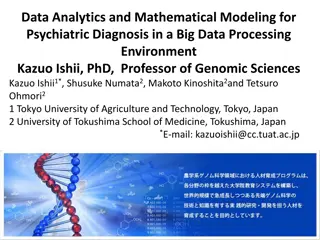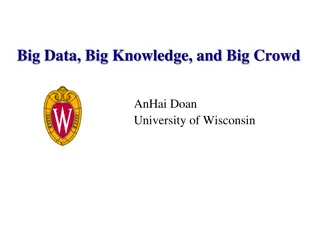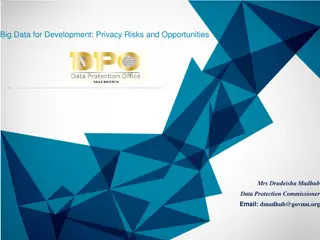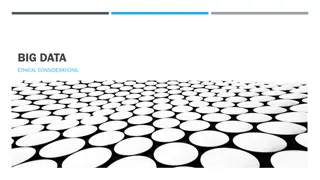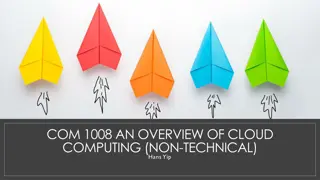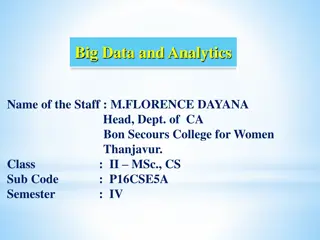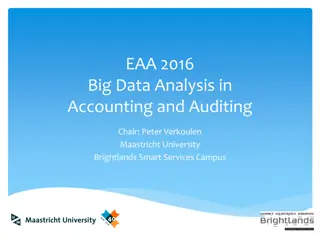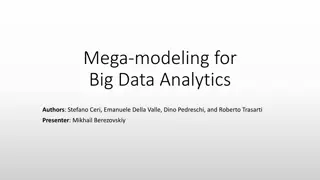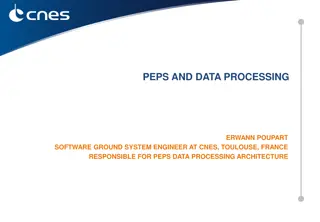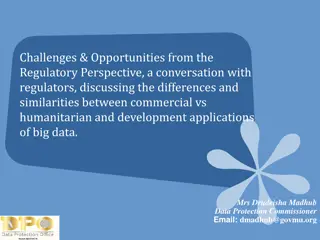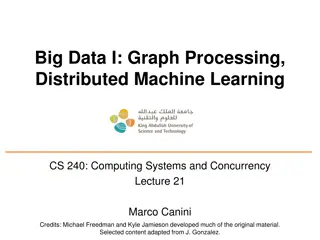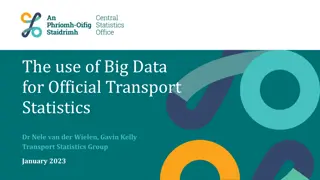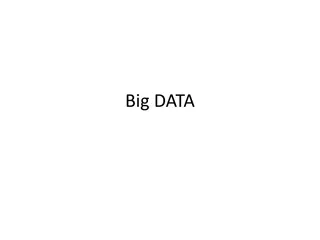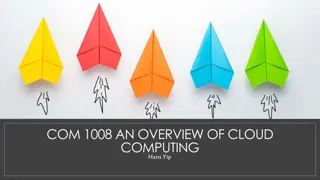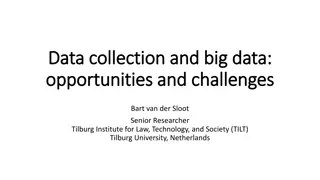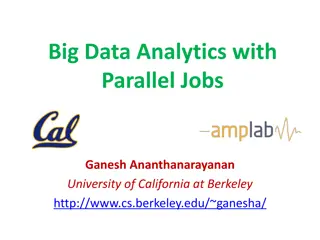Introduction to Big Data Processing
This lecture highlights the significance of big data processing in the era of cloud computing, emphasizing datafication and the challenges presented by large data volumes. It discusses various big data sources, contrasts big and small data, and delves into the three Vs of big data: Volume, Velocity, Variety, along with Veracity. The overall goal of big data processing is to improve analysis for more informed decision-making.
Download Presentation

Please find below an Image/Link to download the presentation.
The content on the website is provided AS IS for your information and personal use only. It may not be sold, licensed, or shared on other websites without obtaining consent from the author.If you encounter any issues during the download, it is possible that the publisher has removed the file from their server.
You are allowed to download the files provided on this website for personal or commercial use, subject to the condition that they are used lawfully. All files are the property of their respective owners.
The content on the website is provided AS IS for your information and personal use only. It may not be sold, licensed, or shared on other websites without obtaining consent from the author.
E N D
Presentation Transcript
Introduction to Cloud Computing Lecture 4-1 Big Data Processing
Outline Computing with Big Data NoSQL 2
Datafication Datafication is a modern technological trend turning many aspects of our life into computerized (usually digital) data transforming computerized data into new forms of values. Value digitalize transform This is how the big data problems arise This is what we need to do in the big data era 4
Data Volume By David Wellman, Director of Software Development at Imagine Health 5
Possible Big Data Sources Activity Data Ex. on-line shopping data Conversation Data Ex. Data on Facebook or Twitter Photo and Video Images Sensor data Internet of Things (IoT) data Genome data of all creatures 6
Big or Small Data? Big data is often described using three Vs: Volume Velocity Variety And big data sometimes should consider another V: Veracity Small Data? Big Data? 7
Three Vs + One V Three Vs: Volume It refers to the amount of data Big data implies enormous volumes of data. Velocity Velocity refers the speed at which data is generated, or the speed at which data moves around (streaming data) Variety Variety refers to the many sources and types of data both structured and unstructured. One V: Veracity Veracity refers to the biases, noise and abnormality in data. 8
Big Data Big Data includes huge volume, high velocity, and extensible variety of data. The data in it will be of three types: Structured data : Relational data. Semi Structured data : XML data. Unstructured data : Word, PDF, Text, Media Logs.
Goal of Big Data Processing It provides more accurate analysis, which may lead to more concrete decision-making resulting in: greater operational efficiencies cost reductions reduced risks for the business Efficiency 11
Choices among Big Data Technologies Commodity vs. exotic hardware Number of machines vs. processor vs. cores Bandwidth of memory vs. disk vs. network Different programming models 12
Software Big Data Technologies In order to handle big data, you will need an architecture that can manage and process huge volumes of structured and unstructured data in real-time can protect data privacy and security Two classes of big data technologies Operational Big Data This includes NoSQL Big Data systems, which take advantage of new cloud computing architectures for massive computations Analytical Big Data It provides analytical capabilities for retrospective and complex analysis that may touch most or all of the data. 13
Operational vs. Analytical Systems for Big Data Operational Analytical Latency 1 ms - 100 ms 1 min - 100 min or more Concurrency 1000 - 100,000 1 - 10 Access Pattern Writes and Reads Reads Queries Selective Unselective Data Scope Operational Retrospective End User Customer Data Scientist Technology NoSQL MapReduce, Massively Parallel Processing (MPP)
Big Data Challenges Capturing data Curation Storage Searching Sharing Transfer Analysis Presentation 15
Big Data Processing Turing big data into values The datafication generates large amounts of data, and we need the latest technology such as cloud computing and distributed systems to leverage all types of data and add value The key is value! It all boils down to Divide-and-conquer Throwing more hardware at the problem Simple to understand a lifetime to master 16
Divide and Conquer Master Process Work Partition w1 w2 w3 Worker Processes Compute worker worker worker r1 r2 r3 Master Process Result Combine 17
Different Workers Different threads in the same core Different cores in the same CPU Different CPUs in a multi-processor system Different machines in a distributed system 18
Parallelization Problems How do we assign work units to workers? What if we have more work units than workers? What if workers need to share partial results? How do we aggregate partial results? How do we know all the workers have finished? What if workers die? What is the common theme of all of these problems? 19
General Theme? Parallelization problems arise from: Communication between workers Access to shared resources (e.g., data) Thus, we need a synchronization system! This is tricky: Finding bugs is hard Solving bugs is even harder 20
Managing Multiple Workers Difficult because (Often) don t know the order in which workers run (Often) don t know where the workers are running (Often) don t know when workers interrupt each other Thus, we need: Semaphores (lock, unlock) Conditional variables (wait, notify, broadcast) Barriers Still, lots of problems: Deadlock, livelock, race conditions, ... Moral of the story: be careful! Even trickier if the workers are on different machines 21
Patterns for Parallelism Parallel computing has been around for decades Here are some design patterns 22
Master/Slaves master slaves 23
Producer/Consumer Flow P C P C P C P C P C P C 24
Work Queues P C shared queue P C W W W W W P C 25
Solutions? From patterns to implementation: pthreads, OpenMP for multi-threaded programming MPI for clustering computing Programming architecture such as Hadoop MapReduce, Spark, The reality: Lots of one-off solutions, custom code Write you own dedicated library, then program with it Burden on the programmer to explicitly manage everything 26
Googles Solution Google File System to manage big data MapReduce to analyze big data Google BigTable as the operational big data system 27
NoSQL 28
History of the World Relational Databases mainstay of business Web-based applications caused spikes Especially true for public-facing e-Commerce sites Developers begin to front RDBMS with memcache or integrate other caching mechanisms within the application 29
Scaling Up Issues with scaling up when the dataset is just too big RDBMS were not designed to be distributed Began to look at multi-node database solutions Known as scaling out or horizontal scaling Different approaches include: Master-slave Sharding 30
Scaling RDBMS Master/Slave Master-Slave All writes are written to the master. All reads performed against the replicated slave databases Critical reads may be incorrect as writes may not have been propagated down Large data sets can pose problems as master needs to duplicate data to slaves 31
Scaling RDBMS - Sharding Partition or sharding Scales well for both reads and writes Not transparent, application needs to be partition- aware Can no longer have relationships/joins across partitions Loss of referential integrity across shards 32
Other ways to scale RDBMS Multi-Master replication INSERT only, not UPDATES/DELETES No JOINs, thereby reducing query time This involves de-normalizing data In-memory databases 33
What is NoSQL? Stands for Not Only SQL Class of non-relational data storage systems Usually do not require a fixed table schema nor do they use the concept of joins All NoSQL offerings relax one or more of the ACID properties (will talk about the CAP theorem) 34
Why NoSQL? For data storage, an RDBMS cannot be the be- all/end-all Just as there are different programming languages, need to have other data storage tools in the toolbox A NoSQL solution is more acceptable to a client now than even several years ago Think about proposing a Ruby/Rails or Groovy/Grails solution now versus a couple of years ago 35
How did we get here? Explosion of social media sites (Facebook, Twitter) with large data needs Rise of cloud-based solutions such as Amazon S3 (simple storage solution) Just as moving to dynamically-typed languages (Ruby/Groovy), a shift to dynamically-typed data with frequent schema changes Open-source community 36
Dynamo and BigTable Three major papers were the seeds of the NoSQL movement BigTable (Google) Dynamo (Amazon) Gossip protocol (discovery and error detection) Distributed key-value data store Eventual consistency CAP Theorem 37
The Perfect Storm Large datasets, acceptance of alternatives, and dynamically-typed data has come together in a perfect storm Not a backlash/rebellion against RDBMS SQL is a rich query language that cannot be rivaled by the current list of NoSQL offerings 38
ACID (atomicity, consistency, isolation, durability) ACID is a set of properties that guarantee database transactions are processed reliably. Atomicity requires that database modifications must follow an "all or nothing" rule. The consistency property ensures that any transaction the database performs will take it from one consistent state to another. Isolation refers to the requirement that no transaction should be able to interfere with another transaction at all. Durability means that once a transaction has been committed, it will remain so. 39
CAP Theorem Three properties of a system: consistency, availability and partitions You can have at most two of these three properties for any shared-data system To scale out, you have to partition. That leaves either consistency or availability to choose from In almost all cases, you would choose availability over consistency 40
Availability Traditionally, thought of as the server/process available five 9 s (99.999 %). However, for large node system, at almost any point in time there s a good chance that a node is either down or there is a network disruption among the nodes. Want a system that is resilient in the face of network disruption 41
Eventual Consistency When no updates occur for a long period of time, eventually all updates will propagate through the system and all the nodes will be consistent For a given accepted update and a given node, eventually either the update reaches the node or the node is removed from service Known as BASE (Basically Available, Soft state, Eventual consistency), as opposed to ACID 42
What kinds of NoSQL NoSQL solutions fall into two major areas: Key/Value or the big hash table . Amazon S3 (Dynamo) Voldemort Scalaris Schema-less which comes in multiple flavors, column- based, document-based or graph-based. Cassandra (column-based) CouchDB (document-based) Neo4J (graph-based) HBase (column-based) 43
Key/Value Pros: very fast very scalable simple model able to distribute horizontally Cons: - many data structures (objects) can't be easily modeled as key value pairs 44
Schema-Less Pros: - Schema-less data model is richer than key/value pairs - eventual consistency - many are distributed - still provide excellent performance and scalability Cons: - typically no ACID transactions or joins 45
Common Advantages Cheap, easy to implement (open source) Data are replicated to multiple nodes (therefore identical and fault-tolerant) and can be partitioned Down nodes easily replaced No single point of failure Easy to distribute Don't require a schema Can scale up and down Relax the data consistency requirement (CAP) 46
What am I giving up? joins group by order by ACID transactions SQL as a sometimes frustrating but still powerful query language easy integration with other applications that support SQL 47
Typical NoSQL API Basic API access: get(key) -- Extract the value given a key put(key, value) -- Create or update the value given its key delete(key) -- Remove the key and its associated value execute(key, operation, parameters) -- Invoke an operation to the value (given its key) which is a special data structure (e.g. List, Set, Map .... etc). 48
